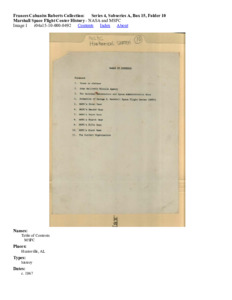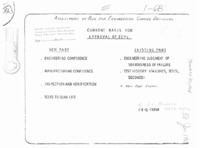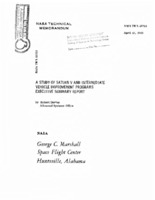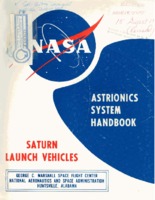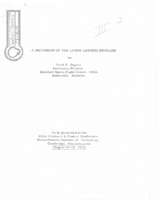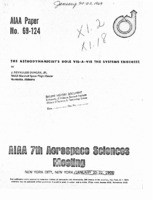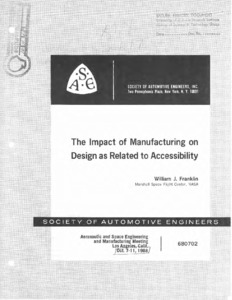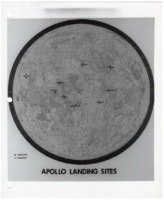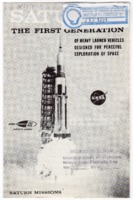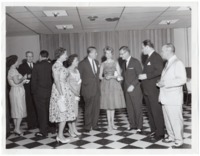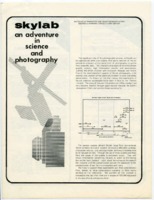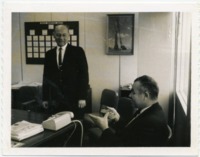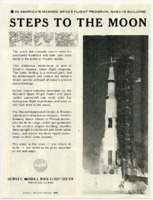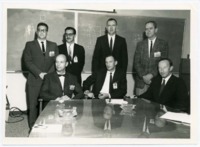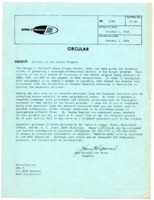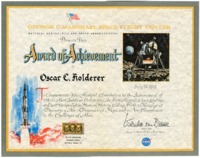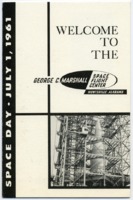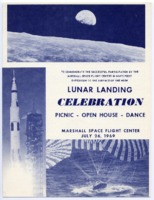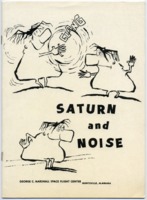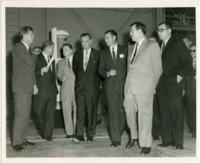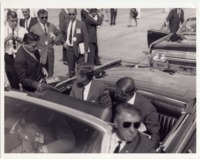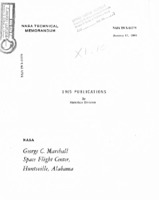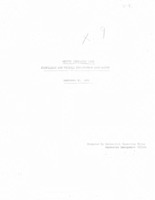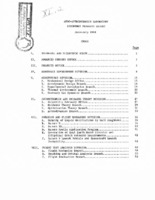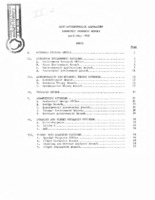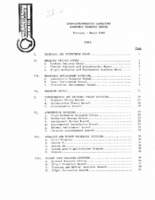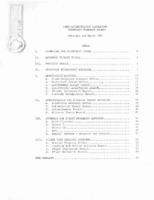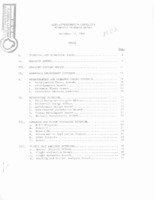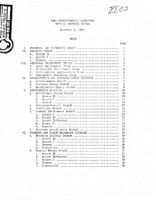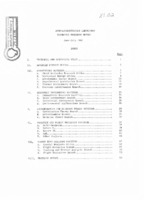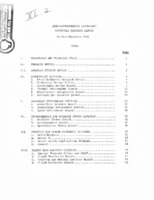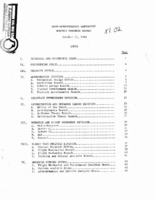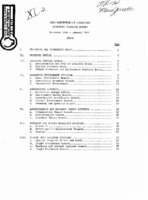
Browse Items (135 total)
Sort by:
-
Marshall Space Flight Center History
NASA and MSFC -
"Assessment of Risk for Engineering Change Decisions."
This document includes the current basis for approval of ECPs, fatigue life after stress reduction, and other probability and comparative risk assessments. On the first page there is an inscription, "By E.L. Bombara NASA-MSFC." -
"A Study of Saturn V and Intermediate Vehicle Improvement Programs Executive Summary Report."
The abstract notes, "The purpose of this report is to summarize the results of three companion studies designed to investigate both the performance growth potential of the Saturn V and the utilization of Saturn V equipment to fill the performance gap in the intermediate payload range between the Saturn IB and the Saturn V. This report includes significant data which is intended to aid the planning of future missions. This data reflects some of the various vehicle configurations which can be used by mission planners to satisfy payload desires in excess of the Saturn IB and Saturn V." -
Saturn Launch Vehicles Astrionics System Handbook, 2nd revised edition.
This updated edition of the Astrionics System Handbook instructs, "The enclosed pages change, delete, or supplement the information in the Astrionics System Handbook (1 August 1965). Insert these pages and destroy the pages they replace." -
Saturn Launch Vehicles Astrionics System Handbook.
Includes change pages. Contract NAS8-14000. Second revised edition. V66-15610. NASA-CR71607. The introduction notes, "This second revised edition of the Astrionics System Handbook has been developed under the direction and overall supervision of Dr. Rudolf Decher of the Astrionics Systems Engineering Office. This description of the Saturn Astrionics System has been generated by personnel of the Astrionics Laboratory, the staff of the Astrionics Systems Engineering Office, and by personnel of the International Business Machines Corporation working under Contract NAS8- 14000. The handbook will be updated and expanded as it becomes necessary due to changes or refinements in the system concept and hardware. Sections not contained in the first release of this document will be made available within three months." Signed by Ludie G. Richard, Chief, Systems Engineering Office, Astrionics Laboratory. The document is missing pages in the following locations: Chapters 8, 9, 12. Sections 15.2, 15.3, 15.4-1 thru 15.4-16, 15.5-1 thru 15.5-2, 15.5-5 thru 15.5-8. -
"A Discussion of the Lunar Landing Problem."
Digesu worked in the Astrionics Division of MSFC. This paper was presented at the AIAA Guidance & Control Conference, Massachusetts Institute of Technology, Cambridge, Massachusetts, August 12-14, 1963. -
"The Astrodynamicist's Role vis-a-vis the Systems Engineer."
By J. Reynolds Duncan, Jr., Aerospace Engineer, NASA Marshall Space Flight Center, Huntsville, Alabama. AIAA 7th Aerospace Sciences Meeting, New York City, New York, January 20 - 22, 1969. -
"The impact of manufacturing on design as related to accessibility."
The purpose of this paper is to emphasize the need for accessibility in the assembly and maintenance of spacecraft. This is especially pertinent because accessibility to subsystems for replacement, repair, and maintenance has proven to be one of the more costly phases of preflight preparation. The most successful programs in this day and age have been when the design and manufacturing engineers work side by side around a mockup where solutions to the problems can be visually seen and solved, keeping in mind the assembly as related to accessibility. Therefore, it will be shown that in order to overcome the difficulties, designers should adapt a hard, fast ground rule that each unit must be accessible and individually removable without disturbing the other units.; Aeronautic and Space Engineering and Manufacturing Meeting, Los Angeles, Calif. Oct. 7 - 11, 1968. -
Abbreviated timeline of the Apollo 11 mission.
The timeline includes a memorandum from Friedjof A. Speer, manager of the Missions Operations Office, to employees of Marshall Space Flight Center. Speer notes that "astronaut Neil Armstrong is scheduled to be the first man to step onto the moon's surface." The timeline outlines the entire mission from liftoff at 8:32 AM on Wednesday, July 16, 1969 to splashdown at 11:49 AM on Thursday, July 24, 1969. -
Map of completed and proposed Apollo moon landing sites.
The map shows landing locations on the moon's surface, including proposed landing sites of the cancelled Apollo 18 and Apollo 19 missions. This map was created as part of the Lunar Roving Vehicle (LRV) Project. -
Two astronauts driving a test model of the lunar roving vehicle (LRV).
Developed by Marshall Space Flight Center and built by Boeing, the LRV was an electric vehicle used to explore the Moon's surface during the Apollo 15, 16, and 17 missions. -
"Saturn I: The First Generation of Heavy Launch Vehicles Designed for Peaceful Exploration of Space."
The leaflet outlines the history of Saturn launches and gives a physical description of the rocket. The description includes a diagram of each stage; specifications of each stage's thrust, propellants, liftoff weight, and burning time; and engine specifications. -
"SkyLab: An Oral History of America's First Space Station."
This video was released in conjunction with Skylab's 30th anniversary in 2003. It contains video footage from the Skylab program as well as interviews with those associated with the program.Tags Oral History -
Wernher and Maria von Braun at a cocktail party given for the Alabama legislature.
A note on the back of the photo reads, "Cocktail Party for legislature at time Huntsville wanted Research Park & Institute for university." From left to right: Mrs. Foster Haley, Mrs. Milton Cummings, Wernher von Braun, Maria von Braun, Roscoe Roberts, Ryan DeGraffenried, and Milton Cummings. -
"Skylab: An Adventure in Science and Photography."
This leaflet gives an overview of types of film and camera systems being used in photography and observations on Skylab, the first space station launched by the United States. -
William A. Schulze and Hans Palaoro at Marshall Space Flight Center.
The bulletin board behind Schulze reads "Vehicle Engineering Branch." Palaoro was the head of the Vehicle Systems Engineering Branch of the Structures and Mechanics Division at Marshall Space Flight Center. -
"Steps to the Moon."
This flier highlights Marshall Space Flight Center's role in the lunar landing and illustrates each step of a successful mission, from liftoff at Kennedy Space Center to splashdown in the Pacific Ocean. -
The Apollo Lunar Surface Drill team at Marshall Space Flight Center.
John Bensko, Jr. is seated in the center of the front row. -
Circular announcing MSFC's involvement with the documentation of the Saturn program at the UAH Research Institute.
The documentation noted in the circular is available at UAH Archives and Special Collections in the Saturn V Collection. -
Marshall Space Flight Center Space Day 1961 program.
The program includes "Marshall Center Highlights" from the Center's first year, a message from director Wernher von Braun, a photograph of the Space Queen and Princesses, and a guide to the Center's buildings. -
Marshall Space Flight Center "Lunar Landing Celebration" program.
The celebration included an employee picnic, a dance, and an open house. -
"Saturn and Noise."
The pamphlet uses a cartoon character named "D. B. Noyes" to explain to the public "the nature and effects of the noise which Saturn makes during static firing tests." -
President John F. Kennedy visits Marshall Space Flight Center.
Shown in the photograph, left to right: President John F. Kennedy, Robert C. Seamans, Wernher von Braun, James E. Webb, Vice President Lyndon B. Johnson, Robert S. McNamara, Jerome D. Wiesner, and Harold Brown. -
President John F. Kennedy being interviewed by a reporter while MSFC director Wernher von Braun looks on.
Kennedy visited Huntsville for a second time on Armed Forces Day 1963. His first visit occurred on September 11, 1962. -
"1965 Publications," Materials Division, George C. Marshall Space Flight Center.
This document is a compilation of abstracts of NASA Technical Memorandums and MSFC Internal Notes, written by personnel of the Materials Division and released during 1965. -
"Aero-Astrodynamics Laboratory Bimonthly Progress Report: June - July 1968."
Includes Technical and Scientific Staff; Advanced Studies Office; Projects Office; Aerospace Environment Division; Aerophysics Division; Astrodynamics and Guidance Theory Division; Dynamics and Flight Mechanics Division; Flight Test Analysis Division. -
"Aero-Astrodynamics Laboratory Bimonthly Progress Report: April - May 1968."
Includes Advanced Studies Office, Aerospace Environment Division, Astrodynamics and Guidance Theory Division, Projects Office, Aerophysics Division, Dynamics and Flight Mechanics Division, Flight Test Analysis Division. -
Reproduction of "Apollo Interface Control Document Log."
This copy is a reproduction of a document held by the NASA Scientific and Technical Information Facility . -
"A Bibliography of Wernher von Braun, 1967."
This official bibliography includes English- and foreign-language books, articles, and interviews.
